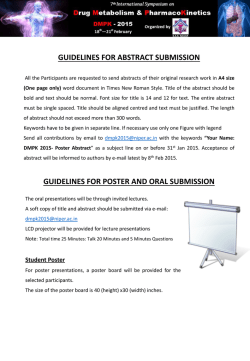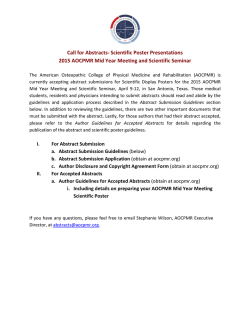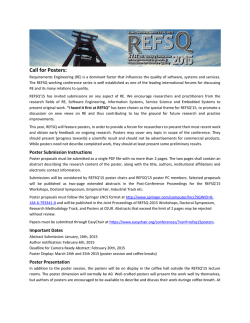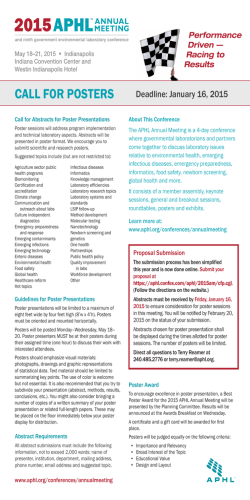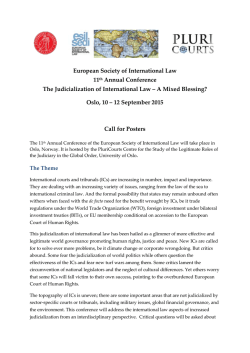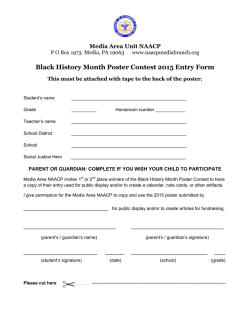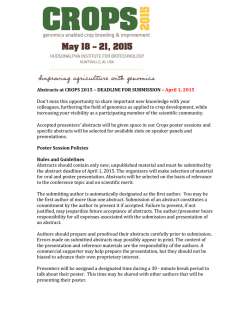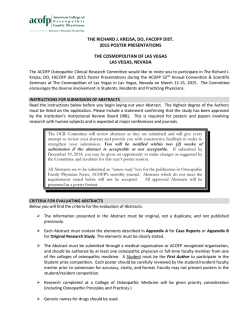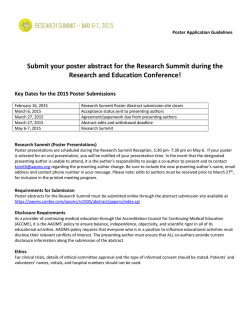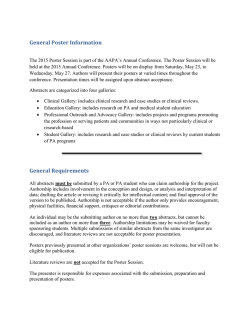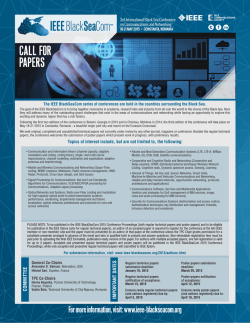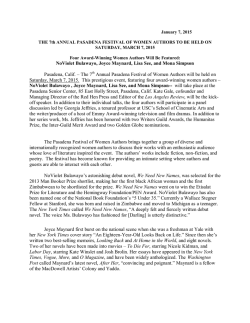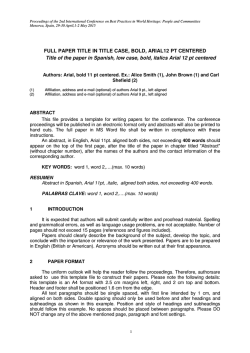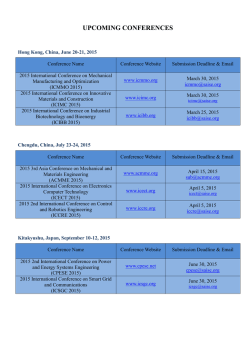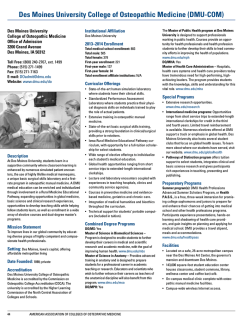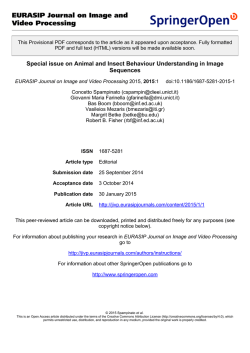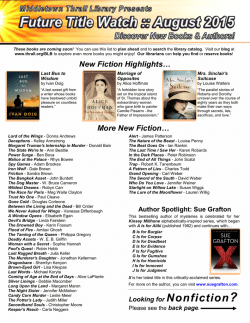
NEW YORK STATE OSTEOPATHIC MEDICAL SOCIETY 2015
NEW YORK STATE OSTEOPATHIC MEDICAL SOCIETY 2015 NYSOMS STUDENT SCIENTIFIC POSTER COMPETITION Experimental Research Friday April 17, 2015 Hyatt Regency Long Island, 1717 Motor Parkway, Hauppauge, NY 11788 A. POLICIES 1. The NYSOMS Annual Experimental Poster Competitions are open only to Osteopathic Students who are members of NYSOMS. 2. Multiple entries are allowed if space permits as per the discretion of NYSOMS. If you are submitting multiple entries, please indicate the order of preference for submission of the abstracts. Only one prize is awarded per Student. 3. Submitted abstracts must be received by January 27, 2015 at 5 PM. ROC-NY poster competition committee will determine if the submission will be accepted for presentation at the poster competition. The authors will be informed of the committee’s decision on their submission(s) by Friday January 30, 2015. 4. All competition participants will receive notification from the NYSOMS office, which will state the exact location and time of the competition. 5. The competitions will take place on Friday April 17, 2015. 6. The competitions will take place in conjunction with NYSOMS’ Regional Osteopathic Convention – New York (ROC - NY). 7. Participants must mount their posters one hour prior to the time of the competition at the designated site after registering at Hyatt Regency Long Island, 1717 Motor Parkway, Hauppauge, NY 8. Posters must be prepared following the NYSOMS’ Poster Competition Application and Presentation guidelines. They must be placed on a rigid backing such that they can be mounted on tables provided in the room. For uniformity, they should be oriented horizontally in a landscape format. 9. The posters will be mounted in a designated exhibit area. 10. Each poster will be mounted in a numbered location that is predetermined randomly. 11. The prize for the First Place Winner in each competition will be $250. Second Place Winners will receive $100. Third Place Winners will receive $50. 12. The competition will be open to research of the type acceptable to the AOA Scientific Conference. The work presented must be the work of the student submitting it. Explanatory clinical research, descriptive clinical studies and health policy, educational, and other research subjects will be accepted. No pure literature reviews will be accepted. Research must have been done when the participant was a medical student.he final posters must contain the results of the study. 13. Points will be deducted if the submitting author is not present at the competition and if the abstract submitted does not follow competition protocol. 14. Entrants are encouraged to submit research that is original to this competition and has not been published. Entries that have been shown at local hospitals, or regional and national conferences, will be accepted. 15. NYSOMS will produce a "book" of abstracts that will be provided to the judges prior to the competition and will be posted on the NYSOMS website. 16. All participants will receive a Certificate of Participation. 17. NYSOMS reserves the right to limit the number of accepted posters based on space availability. 18. NYSOMS cannot be responsible for unclaimed posters following the presentation. NEW YORK STATE OSTEOPATHIC MEDICAL SOCIETY 2015 NYSOMS STUDENT SCIENTIFIC POSTER COMPETITION Experimental Research Friday April 17, 2015 Hyatt Regency Long Island, 1717 Motor Parkway, Hauppauge, NY 11788 B. APPLICATION AND PRESENTATION PROCEDURES 1. The completed signed application(s) and abstract(s) must be sent to NYSOMS electronically via e-mail at [email protected] and received no later than 5 PM on Friday, January 3, 2014. An e-mail confirming receipt of the submission will be sent to each entrant. If the submitting author does not receive the confirmatory e-mail in 1 week, he/she should contact NYSOMS at the above e-mail address. The application form is available from the NYSOMS office or at www.nysoms.org. Note: Faxed submissions will not be accepted. 2. The submitted abstract must not exceed more than 350 words (including title, authors and institutions), must be no longer than one 8.5” x 11" page in minimum 12-point type size and single spaced typed. The margins should be one inch wide. The abstract must contain at least preliminary results, although final results are expected on the poster itself. Acceptance of the poster will be contingent upon the appropriateness of the abstract. Points will be deducted if abstract protocol is not followed. (See Appendix A & B for abstract format and samples). 3. Abstracts for Experimental Research studies must follow the NYSOMS’ Research Abstract Formats and examples (Refer to Appendix A and B). Evaluation of Abstract presentation will be completed prior to the competition and the points will be included in the judging process of the posters. 4. All entrants are required to complete the box on the application form that the research project received IRB approval or state why IRB approval was not necessary. If the information is not supplied, the abstract will not be accepted. 5. The NYSOMS application form must be completed and sent with the abstract and signatures verifying that the work is that of the person submitting it. The signature of the applicant’s DME or program director will be required on each form. Applications will not be accepted without the required signature. 6. The poster itself must be two-dimensional. It should use a horizontal format, not to be larger than 4 ft. by 6 ft. Text must be large enough to be read from a distance of three feet. The text for the title, institution, and authors must be no less than one inch high. 7. Each entrant will have a maximum of four minutes to present their research information to the judges. Only one author will be permitted to present. The presenting author and the author submitting the application must be the same. In the event the entrant author cannot be present, points may be lost for presentation. 8. A panel of judges appointed by NYSOMS will evaluate the posters by using predetermined objective criteria and scoring forms. The judges' decision will be final. Appendix A NEW YORK STATE OSTEOPATHIC MEDICAL SOCIETY Research Study Abstract Format • Title - The title should reflect and concisely describe your research project. • Authors - Include authors name, degree and institutional affiliation • Context/Background - Why is the topic you have selected a problem that needs to be addressed? What is missing from the field of study that your study is going to address? Provide a one-sentence summary of the rationale for the study question. • Objective(s) - What does this study intend to resolve? Provide a one-sentence description (e.g., "To determine…," "To establish…") of the study's primary objective. Authors may choose to include key secondary objectives. • Methods - A short paragraph discussing the design, setting, patients, and interventions. (Refer to the descriptions below.) This section describes how the study was carried out. • Design - A statement of the study's basic design (e.g., randomized controlled trial, double-blind, cohort, survey, cost-effectiveness analysis). Note: Make sure you include in the design statement a notation that the research study was approved by the IRB (institutional review board). • Setting - A one-sentence description of the clinical circumstances of the setting (e.g., general community, primary care center, hospitalized care). • Subjects (or other participants) - A brief description of the key eligibility criteria of the study's participants. The total number of the participants must be included and how many participants were included in each group of the study (i.e. study group(s), control group). • Interventions - A brief description of any interventions administered (e.g. OMM, medications, etc.). • Main Outcome Measure(s) - A brief description of the study’s outcome measurements • (e.g. blood pressure, symptom scores, patient satisfaction scales). • Results - A brief summary of the main results along with declarations and explanations of any important measurements. Authors should include the study’s relevant statistical information (e.g. confidence intervals, levels of statistical significance). • Conclusion - How does this study add to the body of knowledge on the topic? Provide a brief summary of the study's conclusions directly supported by the reported evidence. Authors may include clinical applications and any recommendations for additional study. Note: Abstracts are limited to 350 words (Including title, authors, and institutions) Appendix B Example - Research Study Abstract Title: Interexaminer Reliability for Assessing the Lumbar Spine by Diagnostic Palpation Authors: S. Rivera-Martinez, D.O. (1) J.D. Capobianco, D.O. (2) (1) Long Beach Medical Center, Dept. of Family Practice, Long Beach, NY 11561 (2) New York College of Osteopathic Medicine, New York Institute of Technology Dept. of Osteopathic Manipulative Medicine, Old Westbury, NY 11568 Background: Osteopathic physicians employ diagnostic palpation as a method to evaluate problems of the lumbar spine and to assess the results of manipulative treatment. However, the reliability of this primary diagnostic tool has not been well established. Objective: The objective of this study is to determine if training the examiners on a specific methodology of palpatory diagnosis has a significant impact on the outcome of interexaminer agreement. Methods: The research protocol was approved by the NYCOM/NYIT IRB. It was designed as a pre and post training examiner reliability study on the interobserver agreement. A total of sixty subjects and four examiners were recruited. At each session the examiners diagnosed L1-L5 lumbar spinal segments for rotational asymmetry by static palpation and for severity of the asymmetry by motion- based palpation. The transverse processes of the lumbar spinal segments were clearly identified to ensure consistent palpation of the same anatomic site. Thirty subjects participated in the pre-training session to obtain baseline examiner concordance. Following the pre-training session an expert in diagnostic palpation trained the examiners. In the post-training session the examiners diagnosed another thirty subjects utilizing the methods demonstrated by the expert during the training sessions. Kappa statistics were computed to compare pre and post training results. Results: Poor interexaminer concordance was demonstrated in the pre-training session with Kappa coefficients of 0.087 for static asymmetry and 0.082 for motion-based severity rating. In contrast, acceptable concordance was obtained in the post-training session with kappa coefficients of 0.52 and 0.50 for static and motion-based palpation respectively. Conclusions: Kappa scores indicating improved interexaminer concordance after training the examiners on specific palpatory procedures was established. The results of this study suggest that standardization of the methods utilized by each examiner to determine a palpatory diagnosis may have a positive influence on interobserver agreement.
© Copyright 2026

